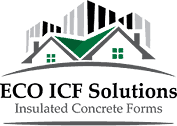ECO-Block Used in Largest ICF Community in the Country
26 August 2003Ft. Lauderdale, Fla. – ECO-Block will soon be a main support for the largest insulating concrete forms (ICF) community in the United States. Scheduled to begin building September 2, The Villages at Rio Del Sol is a 270-plus home, gated community located near Palm Springs in Cathedral City, Cal. Currently, 160 of the homes will be built with ECO-Block ICFs.
“Response on these homes has been very positive and leaves a strong potential for building more ECO-Block homes in Rio Del Sol,” reports Michael Gandee, ECO-Block regional manager, California.
ECO-Block, the leader in insulating concrete form technology, incorporates a state-of-the-art concept, using expanded polystyrene (EPS) panels that are assembled into forms and then filled with concrete. Once the concrete cures, the panels remain in place as a permanent part of the building, providing built-in insulation.
“The greatest benefit by far of using ECO-Block is the potential for energy savings,” said Joe Morreale, project manager and general contractor. “The extreme heat of southern California takes its toll on local residents’ energy bills. Cooling a 2,800-square-foot house – the average size of a Rio Del Sol home – can run $600-700 a month. By using ECO-Block, we expect our residents will save a minimum of 50 percent.”
Continues Morreale, “ECO-Block’s benefit of added noise reduction also suits this community well. With the cost of property in California, this area is designed for maximum space utilization. While houses may be positioned closer together, our residents will still enjoy privacy and a noise-free environment.”
All homes are designed to meet seismic-zone four building requirements, for the strongest earthquakes, as is required in all California construction.
The first steps include building six models running in size from 2,200 to 3,000 square feet. These “spec” homes sell in the price range of $375,000 to $550,000. Each home will use between 550 and 600 blocks.
To build the first homes, the ECO-Block installation company, ICF Installers, will have four crews on the job site plus help from ECO-Block certified trainers. They plan to build the six homes in three to four weeks and then roll into a four-house-per-week schedule, though that may increase to six homes per week.
“This short of a timeline called for some creative thinking,” reported George Eastom, president, ECO-Block of Southern California and ICF Installers. “We developed a system of installing ECO-Block specifically for this job. It not only accommodates the production needs of the builder, but also allows us to realize new efficiencies.”
In brief, the system calls for marking all interior and exterior walls throughout the site at once. These lines will be coated to protect them. The crews will then put up the ECO-Block walls, bracing them on the outside. Another crew will put together movable scaffolding, which will be used to fill the concrete within the walls. Once the walls are set, workers move the scaffolding on to the next house. The builder’s crew can begin framing the interior walls the day after placing the concrete. This process will save one-and-a-half to two days work per house.
The Portland Cement Association, the California chapter, the California Cement Promotional Council and the Southern California ReadyMix Association have budgets in place to promote this project as a collaborative effort.

